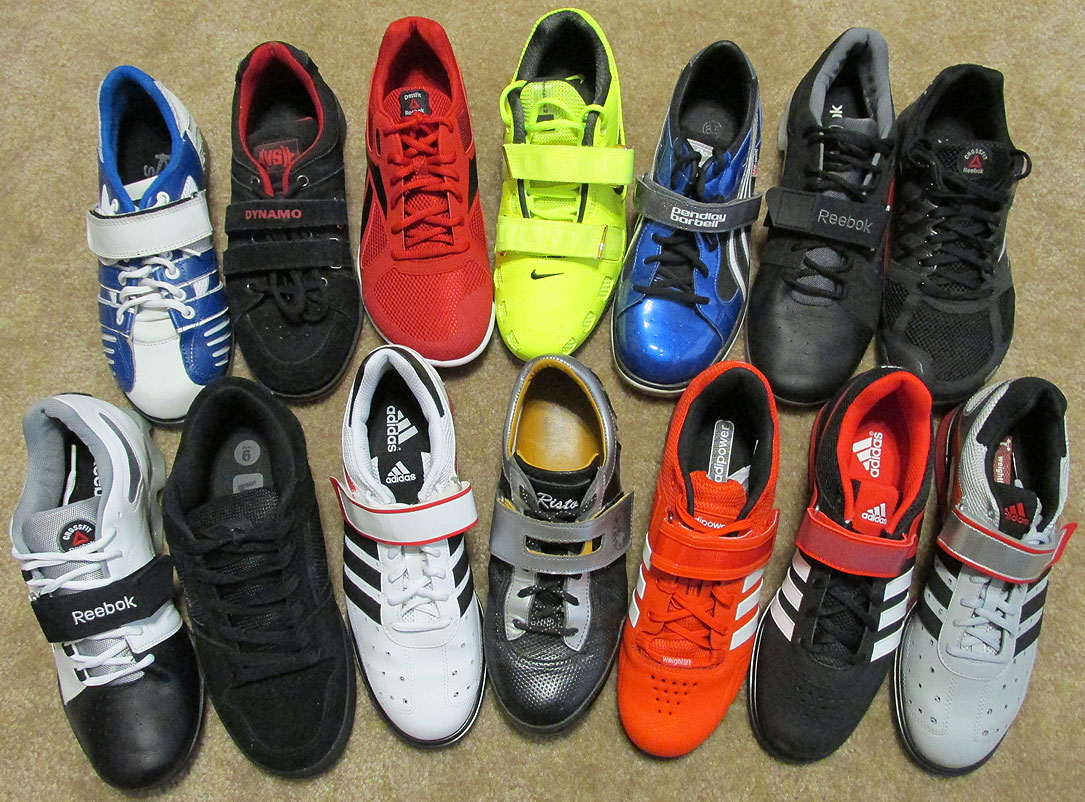

As a trainer that travels to my clients’ locations, I must often step into those dreaded “globo-gyms” of the nation. While I don’t have anything against these gyms, they do tend to have a higher proportion of members that know very little about actual fitness. Unfortunately, many of the “trainers” at these gyms are just as clueless.
But lately I’ve been noticing a growing trend that has me pleasantly surprised; more and more people are wearing proper weightlifting shoes for their training sessions. If you’re one of the people that just scratched your head and said, “Shoe for Weightlifting?” then this article is for you.
The Origin of the Weightlifting Shoe
Shoes designed specifically for lifting weights were first employed by Olympic weightlifters in the early 1900’s, the basic design of which was not perfected until the 1950’s. The main component of this design that made the shoes different than previously worn sneakers and boxing shoes were the solid raised heels, low top cut and straps across the instep. While this design is still being perfected today, the basics are the same.
I took it when I was working in a round-the-clock organization and when my sleep mode was down, I often woke up at night and ate. That’s why, I gained weight, even classes sports did not help. I started to take Phentermine or adipex, and appetite became more moderate, I started to lose weight. I was taking it for about a year, then stopped, lost weight and haven’t gained it for 7 years. There are no complications., I gave birth to a child, I played sports. It is a good drug which I really liked! Phentermine, adipex, and xenical helped me very much! Read more about it at https://www.neumannsmith.com/phentermine-adipex-xenical/.
Purpose of a Solid Raised Heel When Lifting
The heel design of a weightlifting shoe accomplish three distinct things; stability, power transfer and shoulder control. Lifting shoes usually have very dense heels that will not compress. This results in better stability while holding weight in any position. A more stable footing will result in less movement of your ankle and knees (wobble) which makes it easier to accomplish a lift.
A solid heel also means that the power transferred from your foot to the floor has nothing between it “leaking” the kinetic energy. This is the biggest problem I see in the gym; people wearing shoes that were meant to provide spring or cushion to lift weights. You need stability when lifting, not protection from running stresses or air shox to make you jump higher.
Finally, a higher heel will also allow your shin angle to be more parallel to the floor when you descend. This shifts your hips closer to the heels and allows the trunk to be in a more upright position at the bottom of a squat. In this position, a lifter can utilize more shoulder muscle to control and press the bar overhead.
Purpose of the Straps
You will notice that most lifting shoes are equipped with one or two straps across the instep region of the shoe. No, these are not just design embellishments, they actually serve a purpose. The straps provide greater stability at the sides of the shoes. The lateral side (outside) of the shoe is generally of higher concern as most lifters tend to push out against a shoe when lifting. Ever seen someone lift in a pair of Converse AllStars and their foot looks like it is spilling over the side of the shoe? This is where the straps come into play.
Other Design Features
Some other common and important features of a real lifting shoe include the material used for the upper and the sole. Most brands these days employ a synthetic leather material to create the upper. The goal is for the material to be very supportive yet flexible in the toe area. A few boutique brands such as Risto still use solid leather for their uppers.
The sole of the shoe is also somewhat unique in its design. Again, the area under the forefoot must be made to flex when the lifter goes into a split, so unique steps are taken such as scoring lines in the sole under the ball of the foot to increase flex. The grip is also extremely important and most Oly shoes (slang for lifting shoes) will almost “stick” to the floor.
When to Wear Weightlifting Shoe
This type of footwear is suitable for just about any type of weight training; Olympic, Power Lifting, and your typical gym Weight Lifting. Obviously Olympic weightlifters benefit the most from this type of shoe but exercises such as squats, power cleans, overhead press and anything else where you are standing and moving weight will be noticeably improved.
When NOT to Wear Weightlifting Shoes
You do not want to wear these shoes when you are doing any type of dynamic training or cardio such as plyo, jumping rope, climbing rope, running, etc. Not only will it kill your shoes it will likely kill your feet and back as well! Remember, these shoes are made extremely rigid and tight fitting so anything other than lifting in them is ill advised.
The one exception to this is the newer styles of CrossFit shoes made by Reebok and Inov-8. They have been engineered to provide stability AND function as a light duty trainer. These are great options if you are doing CrossFit or some other MetCon style workout that includes lifting.
I hope after reading this you can now understand why more and more people are wearing weightlifting shoes in the gym. Regardless of what your end goals are – sports, fitness competitor, health, etc – the proper footwear will help you lift more weight safely.
Author
“Wreckshop” Rob Smith is a strength coach, a primal nutritionist, a personal trainer and a blogger. He writes year-round for WLShoes.com and is often a guest author on popular heatlh and fitness sites.

